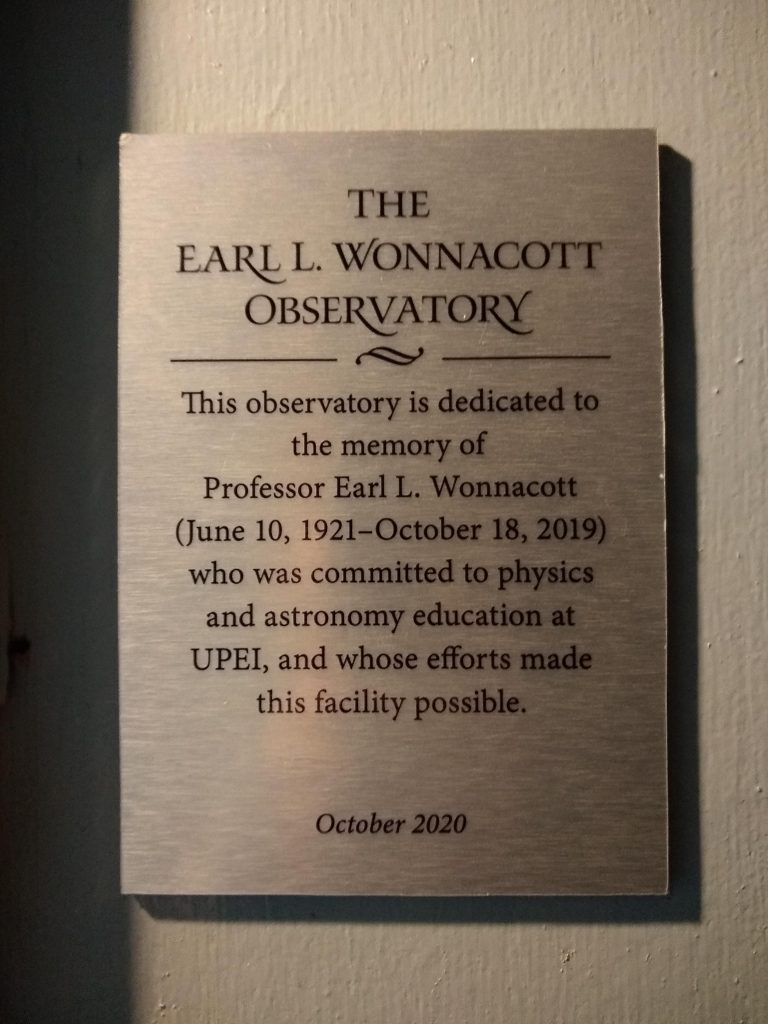The UPEI Physics department has a long history of teaching introductory astronomy and providing astronomy outreach dating back almost as long as the institution of UPEI itself.
Much of the early history of UPEI Astronomy outlined below was sourced from this article by retired physics professor and astronomy instructor, the late Earl Wonnacott.
Teaching Astronomy
Introductory astronomy was first taught in 1975 and some form of astronomy course has been taught for every year since. For many years, the courses were: Physics 251 – Introductory Astronomy I which taught students about the basics of our night sky and the solar system and Physics 252 – Introductory Astronomy II which went beyond our solar system to discuss stars, black holes, galaxies, and the origin of the universe.
In 2015, the Department of Physics revised its astronomy course offerings. A new web course, Physics 1510 – Life in the Universe, was introduced with the hope that the topics covered would appeal to students in all faculties at the university. This course explores what conditions are required for life to exist through studying the evolution of stars and planets. The previous astronomy courses were revised into one course with a laboratory component, Physics 2920 – Stars, Galaxies, and the Universe, which requires that students have taken a previous physics course.
The UPEI Observatory

In the early days of astronomy instruction, the observation facilities available to the students were a bit rough. The department had a 6-inch telescope which was stored in a shed on top of the Duffy Science Building.
For each observation session, the telescope had to be unpacked and set-up on the roof. The viewing location was exposed to the prevailing winds, so dust covers were lost, snow accumulated, and students were probably pretty cold!
Observation facilities improved with the installation of an observation dome (made by Ash Manufacturing) on top of the roof of the newly renovated Memorial Hall. Memorial Hall re-opened in September 1979 and the telescope dome was added in January 1980. A 14-inch Celestron (Schmidt-Cassegrain) was installed on the dome’s concrete pier and the “UPEI Observatory” was ready for use by August 1980.

In the years since, the UPEI Observatory has welcomed thousands of visitors and students to view the wonders of the night sky, despite the challenges presented by Charlottetown’s frequently cloudy skies and growing light pollution.
After over 25 years of use, the observatory’s Celestron-14 telescope, whose optics were degrading, was replaced by a brand-new 14-inch Meade RCX400 in 2006.

(Celestron photograph property of UPEI Physics; Meade photograph from Meade Instruments)
Due to some troubles with the electronics in our 14-inch Meade telescope, we removed it from the observatory in the summer of 2013. The telescope that replaced it for several years was an 8-inch Meade LX80 which was kindly donated to us by Mr. Pat Sinnott, a member of the UPEI Board of Governors.
In 2018, we finally decided that our 14-inch Meade was no longer worth the effort of further repair. We purchased a 11-inch Schmidt-Cassegrain telescope, the Celestron CPC 1100 StarBright XLT GPS. So far, this telescope has functioned well and provided us with some wonderful views.

Professor Earl Wonnacott

Astronomy at UPEI owes much to the interest and efforts of professor Earl Wonnacott. Professor Wonnacott had a long career at UPEI, beginning at its predecessor institution, Prince of Wales College.
Professor Wonnacott taught physics and astronomy for decades and inspired generations of students. He hosted the public at the observatory and even held events with his own personal telescope, like he did in 1994 for a partial solar eclipse when he was interviewed by CBC PEI. He was known for his kind and quiet matter and dedication to education

In October of 2020, our observatory was named the “Earl L. Wonnacott Observatory” to recognize Professor Wonnacott’s contributions to facility’s existence and to education on PEI more broadly. The naming of the observatory marked 40 years since it had been in use and one year since the passing of Earl Wonnacott.

The UPEI Planetarium
Islanders of a certain age may remember that UPEI once had a planetarium. The planetarium consisted of an 18-metre geodesic dome housing the theatre and an attached building with support facilities. Construction began in the fall of 1980 and was finished in time for the first show on July 1 of 1981.
For several years, the planetarium welcomed thousands of guests. It was open in the summer to tourists and the local public and ran special shows during the colder months for school, youth, and community groups. Michelle Cottreau worked at the planetarium during her student days at UPEI. She remembers her job there fondly and wrote: “We had several different shows but my favourite was the one we did for young children called ‘Our Sky Family’. The star projector was nick-named ‘Jake’ and the show began with the sound of snoring. Jake would suddenly wake up and would rise out of the underground well (where the projector was stored) to greet the children and the show began. They loved it!”

Photograph provided by Michelle Cottreau.
However, the facility itself was plagued by maintenance issues. There were temperature control problems with the planetarium being too hot in summer and it leaked whenever it rained. The planetarium fell into disuse in the late 1980s and after a pipe burst in the winter of 1989, the university decided to remove it from campus. A crane dismantled the planetarium and it eventually found its way to a new home at an amusement park in Stanley Bridge.

(Photo source: http://www.sciencefun.com/)



